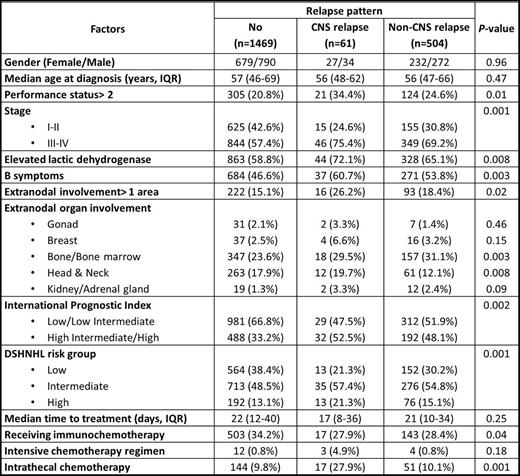Abstract
Introduction: Despite improved treatment outcome of DLBCL in the immunochemotherapy era, secondary CNS relapse remains a serious and fatal complication. Several prognostic models were reported in order to define high-risk patients for CNS relapse and provide proper prophylactic strategies. There is no standard approach for CNS prophylaxis in DLBCL with more data suggesting lack of efficacy of intrathecal chemoprophylaxis. In 2013, the DSHNHL introduced a prognostic model including each international prognostic index (IPI) factor (age, lactate dehydrogenase (LDH), stage, performance status (PS), extranodal involvement (EN) and kidney/adrenal involvement) to stratify patients into 3 groups. Herein, we applied and validated DSHNHL model to DLBCL patients treated at nationwide University hospitals in Thailand including analyzing an impact of rituximab and intrathecal chemoprophylaxis on CNS relapse.
Method: From the nationwide multicenter registry of 4,371 newly diagnosed lymphoma patients in Thailand between 2007 and 2014, there were a total of 2,399 DLBCL patients. We looked at the incidence and clinical predictors of CNS relapse, the effect of immunotherapy and intrathecal chemoprophylaxis on CNS relapse in DLBCL who were treated with at least one cycle of CHOP-like or intensive chemotherapy regimens.
Result: After excluding patients with CNS/ocular involvement at diagnosis, 2,034 DLBCL patients were included in the analysis. Table 1 summarizes baseline characteristics of DLBCL patients. The median follow up time for living patients was 51 months (interquartile range, 22-75 months). A total of 565 patients (27.8%) progressed or relapsed after first-line induction therapy and 61 patients (3.0%) developed CNS relapse. Median time to CNS relapse was relatively shorter than non-CNS relapse (8.4 vs 10.5 months, P=0.07). A total of 729 (35.8%), 1,024 (50.3%) and 281 (13.8%) patients were classified as low-, intermediate- and high-risk groups based on DSHNHL risk model for CNS relapse. Of high DSHNHL risk group, 45 patients (16%) received intrathecal chemotherapy for CNS prophylaxis along with induction treatments. Using the competing risk regression analysis, 2-year cumulative incidence of CNS relapse was 2.7% (1.5%, 3.1%, and 4.6% for low-, intermediate- and high-risk DSHNHL group respectively). Univariate analysis showed elevated LDH, poor PS, stage III/IV, presence of B symptoms, higher risk IPI and DSHNHL risk group as risk factors of CNS relapse (Table 2). Presence of concurrent EN involvement more than one site and elevated LDH was a significant predictor of CNS relapse (Hazard Ratio [HR] 2.39, P =0.004). Kidney/adrenal gland and gonadal involvement were not associated with higher risk of CNS relapse whereas breast involvement showed a trend toward higher incidence of CNS relapse (HR 2.46, P=0.07). Either immunochemotherapy or intrathecal chemoprophylaxis was not associated with lower risk of CNS relapse; in fact patients who received intrathecal chemotherapy had more CNS relapse though this could be due to selection bias. Median survival of patients with CNS relapse was 13.2 months which was significantly worse than patients without CNS relapse (81.8 months, P<0.001).
Conclusion: The 2-year cumulative incidence of CNS relapse in DLBCL in this analysis was 2.7% which was comparable to other series. Using the DSHNHL prognostic model was able to define DLBCL patients into low, intermediate and high risk for CNS relapse. The high-risk group in our series had lower incidence of CNS relapse compared to German and recently reported British Columbia cohorts. Our study confirms poor survival outcome of DLBCL patients with CNS relapse and no protective effect of immunochemotherapy or intrathecal chemoprophylaxis on the incidence of CNS relapse. Novel risk-adapted CNS prophylaxis strategies are warranted to be further investigated in prospective studies.
Baseline characteristics of DLBCL patients based on pattern of CNS relapse
IQR: Interquartile Range
Baseline characteristics of DLBCL patients based on pattern of CNS relapse
IQR: Interquartile Range
Univariate analysis for factors associated with risk of CNS relapse
DSHNHL: The German High Grade Non-Hodgkin's Lymphoma Study Group, R:Rituximab
Univariate analysis for factors associated with risk of CNS relapse
DSHNHL: The German High Grade Non-Hodgkin's Lymphoma Study Group, R:Rituximab
1A shows cumulative incidence (CI) of CNS relapse. 1B shows CI of CNS relapse stratified by the presence of > 1 extranodal involvement and elevated LDH. 1C shows CI of CNS relapse stratified by DSHNHL risk group. 1D shows overall survival based on relapse status.
1A shows cumulative incidence (CI) of CNS relapse. 1B shows CI of CNS relapse stratified by the presence of > 1 extranodal involvement and elevated LDH. 1C shows CI of CNS relapse stratified by DSHNHL risk group. 1D shows overall survival based on relapse status.
Khuhapinant:Roche: Honoraria.
Author notes
Asterisk with author names denotes non-ASH members.




This feature is available to Subscribers Only
Sign In or Create an Account Close Modal